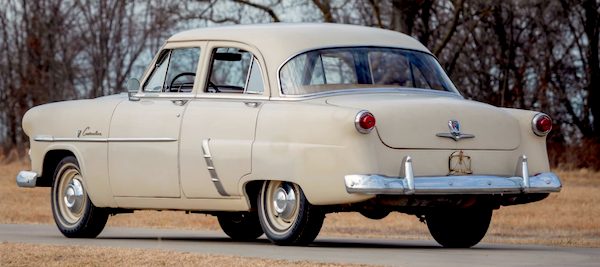By the 1949 model year American automobile design had essentially completed its evolution from circa-1930 boxy designs with separate functional components such as headlights, fenders and running boards to "envelope" styles that were more streamlined and where such features were entirely or mostly incorporated into the overall shape of the car.
As I wrote
here, one last important step remained: lowering the hood. Ford Motor Company was the first of Detroit's "Big Three" carmakers to take this step across its entire brand portfolio. (Studebakers's redesigned 1947 line had fairly low hoods, but not as low as Ford's designs. The redesigned 1952 Nash's hoods were lower than the nearby fenders, but Nash was not a major carmaker. See the first link above for more examples.)
Ford stylists and consulting stylists created the redesigned 1952 line with all the key post-evolution features in place. Fenderlines were high and simple. Hoods were not much higher than the fenders. The overall design was what was later called "three-box," with a somewhat angular passenger compartment greenhouse and a bustleback trunk echoing the hood up front. In
this post, I presented a walkaround of a 1952 Mercury.
The present post compares four-door sedans for the Ford, Mercury and Lincoln brands. Ford and Mercury shared the same basic body, though Mercury's wheelbase was three inches (76 mm) longer. Higher-priced, lower production Lincolns used a different body. This lack of body-sharing with another brand was not an economical practice. General Motors' high price Cadillac brand shared bodies with some Buick and even Oldsmobile models in those days.
Unless noted, images below are of cars listed for sale.
Gallery
1949 Ford - factory image
To me, the '49 Ford epitomizes the end of the evolutionary period. The next-generation Ford Motor Company line's styling was a refinement of this.
1949 Chevrolet Styleline DeLuxe
A major competitor with a tall hood and lower fenders.
1949 Lincoln Sport Sedan
Ford's 1949 Mercury and Lincoln designs also had tall hoods because their design themes were set before the 1949 Ford was created.
1952 Ford Customline - factory image
This model was Ford's best-seller for 1952. Details included "frenched" headlight assemblies, a one-piece curved windshield, and side sculpting suggestive of an air intake (to provide visual relief from what otherwise would be plain sides).
1952 Mercury Custom - factory image
Mercurys used the same side sculpting, but the fake air intake is more believable. Plus, the hood also sports a fake air scoop. Like Ford, headlight assembles are "frenched" to create a little more fender length.
1953 Lincoln Capri
I couldn't find some suitable views of 1952 Lincoln four-door sedans. But 1953 models were almost identical. Even though the body is different from Ford and Mercury, the basic theme is the same. Including the fake fender air intake feature. Headlights are not frenched, however.
1952 Ford Customline - Mecum Auction photo
Rear fenders terminate in round taillight housings that further lengthen the fenderline. The backlight window is panoramic, and one-piece. Rear license plates covered a central fuel door, a convenience feature stressed in Ford advertising.
1952 Mercury Custom
Mercury tail light assemblies leaned forwards, not contributing to an extended fenderline.
1952 Lincoln Capri
For some reason Lincoln's backlight was three-piece.
1952 Ford Customline - Mecum photo
Now for side views that are best for showing structural comparisons.
1952 Mercury Custom
Mercury's greater length was created forward of the cowling and front door leading edge cutline. Aside from chrome trim, front wheel openings, and different tail light assemblies, the Ford and Mercury sedans are structurally the same.

Lower-body door cut lines are similar to Ford's and Mercury's, so it's possible that the Lincoln body shared some of their structure.











.png)




%20-%20rught%20front%2023.png)
%20-%20unknown%20-%20right%20front%2034.png)

































